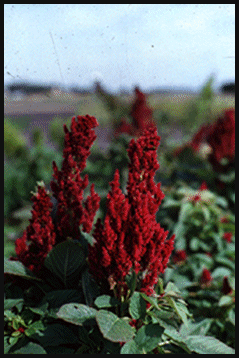Provident Principles and Practices
© David Edwards , 2008.+
© David Edwards , 2008.+
..+ ...
...
PRINCIPLE: “All grain is good for the food of man” – Doctrine and Covenants, 89:16PRACTICES: Many grain-like foods and grains other than wheat have great flavors. Some provide lysine, which in wheat is deficient. Grains store for years in cool, dry, oxygen-free settings. Ground grain, or flour, has a short shelf life. Some grains can be soaked before cooking to cook faster.
 Spelt and Kamut. Spelt and Kamut are hard grains related to wheat. They can be tolerated much better by many people allergic to wheat. Like wheat, spelt or kamut can be stored for decades.
Spelt and Kamut. Spelt and Kamut are hard grains related to wheat. They can be tolerated much better by many people allergic to wheat. Like wheat, spelt or kamut can be stored for decades. Rye and Triticale. Rye, a soft grain, may store for 6-9 years. Triticale, a cross of wheat and rye, contains much less gluten than wheat. It is a harder grain. Triticale can be stored for decades.
Rye and Triticale. Rye, a soft grain, may store for 6-9 years. Triticale, a cross of wheat and rye, contains much less gluten than wheat. It is a harder grain. Triticale can be stored for decades. Oats. Rolled oats (rolled hulled oats, called groats) are often used for making hot cereals or cookies or for thickening soups or stews. Properly stored, rolled oats may last for decades.
Oats. Rolled oats (rolled hulled oats, called groats) are often used for making hot cereals or cookies or for thickening soups or stews. Properly stored, rolled oats may last for decades. Rice. Brown rice has a chewy texture and wonderful flavor, but it generally goes rancid after about six months in storage due to deterioration of fat in the germ unless special storage methods are used. Freezing can lengthen the shelf life. If oxygen is also removed, then storage life can be lengthened to several years. White rice, much less nutritious, stores for decades under proper storage conditions.
Rice. Brown rice has a chewy texture and wonderful flavor, but it generally goes rancid after about six months in storage due to deterioration of fat in the germ unless special storage methods are used. Freezing can lengthen the shelf life. If oxygen is also removed, then storage life can be lengthened to several years. White rice, much less nutritious, stores for decades under proper storage conditions. Popcorn. Popcorn grains can be popped and/or milled into meal or flour. Since popcorn grains are hard, trying to grind them with weak mills may damage them. Under ideal conditions, popcorn grains can be stored for years.
Popcorn. Popcorn grains can be popped and/or milled into meal or flour. Since popcorn grains are hard, trying to grind them with weak mills may damage them. Under ideal conditions, popcorn grains can be stored for years.Millet. Millet is a hard cereal grain; essentially a complete protein; gluten-free; alkaline; easily digestible. Not ground, it takes about 30-60 minutes to cook; if ground or soaked, it cooks faster.
 Quinoa. Quinoa consists of grain-like fruit/seeds that when cooked can be eaten like rice or cereal. Seeds have high nutritional content, and no gluten. Quinoa contains about 12-18% protein, a balanced set of amino acids including lysine, and essential fiber and minerals. Most quinoa sold in the U.S. is already washed; otherwise, it must be washed thoroughly to remove bitter saponins from its outside surfaces. A soft grain, quinoa may last 6-9 years in storage under optimal conditions.
Quinoa. Quinoa consists of grain-like fruit/seeds that when cooked can be eaten like rice or cereal. Seeds have high nutritional content, and no gluten. Quinoa contains about 12-18% protein, a balanced set of amino acids including lysine, and essential fiber and minerals. Most quinoa sold in the U.S. is already washed; otherwise, it must be washed thoroughly to remove bitter saponins from its outside surfaces. A soft grain, quinoa may last 6-9 years in storage under optimal conditions. Amaranth. Amaranth, like Quinoa, consists of grain-like fruit/seeds having high nutritional content: 12-18% protein; high in lysine; gluten-free; with much fiber. It must be cooked. It can be ground and used in bread flour (up to 25%). Amaranth seeds can also be toasted or popped. The seeds can also be rolled like oat groats and cooked. Under good conditions, Amaranth can be stored for years.
Amaranth. Amaranth, like Quinoa, consists of grain-like fruit/seeds having high nutritional content: 12-18% protein; high in lysine; gluten-free; with much fiber. It must be cooked. It can be ground and used in bread flour (up to 25%). Amaranth seeds can also be toasted or popped. The seeds can also be rolled like oat groats and cooked. Under good conditions, Amaranth can be stored for years.Buckwheat. High in lysine content and protein (11-14%) and gluten-free, buckwheat fruit/seeds have three sides. The seeds toast well to become nutty-flavored Kasha. Buckwheat flour is used for making pancakes. Stored properly, buckwheat may last for many years.
Credits (graphics retrieved 2 Sept 2008 from the following sources):
Spelt: Tracey Slotta @ USDA-NRCS PLANTS Database at http://plants.usda.gov/gallery/standard/trsp3_001_shp.jpg
Rice: http://earthobservatory.nasa.gov/Newsroom/NasaNews/ReleaseImages/20050718/01_ricefields.jpg ..
Quinoa: http://en.wikipedia.org/wiki/Image:Chenopodium_quinoa0.jpg By Kurt Stueber. Permission is granted to copy, distribute and/or modify this photo under the terms of the GNU Free Documentation License, Version 1.2 or any later version published by the Free Software Foundation.